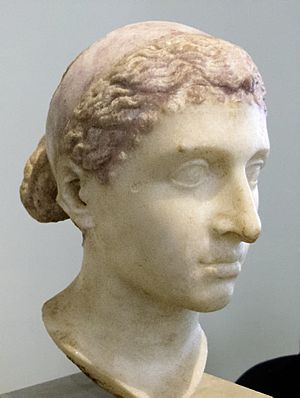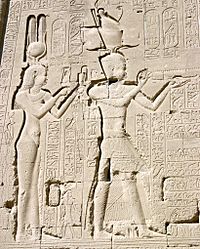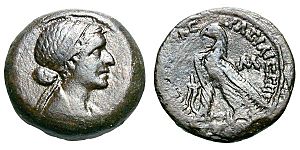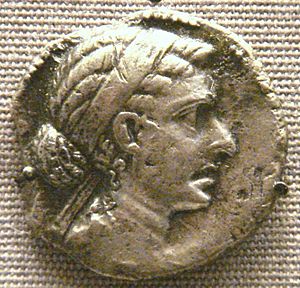Cleopatra facts for kids
Quick facts for kids Cleopatra VII Philopator |
|||||
|---|---|---|---|---|---|

Bust believed to be of Cleopatra VII, Altes Museum, Berlin
|
|||||
| Queen of Ptolemaic Kingdom | |||||
| Reign | 51 – 12 August 30 BC (21 years) | ||||
| Predecessor | Ptolemy XII Auletes | ||||
| Successor | Ptolemy XV Caesarion | ||||
| Co-rulers | Ptolemy XII Auletes Ptolemy XIII Theos Philopator Ptolemy XIV Ptolemy XV Caesarion |
||||
| Born | 69 BC Alexandria, Ptolemaic Kingdom |
||||
| Died | 12 August 30 BC (aged 39) Alexandria, Egypt |
||||
| Burial | Unknown (probably in Egypt) | ||||
| Spouse | Ptolemy XIII Theos Philopator Ptolemy XIV Mark Antony |
||||
| Issue | Caesarion, Ptolemy XV Philopator Philometor Caesar Alexander Helios Cleopatra Selene, Queen of Mauretania Ptolemy XVI Philadelphus |
||||
|
|||||
| Dynasty | Ptolemaic | ||||
| Father | Ptolemy XII Auletes | ||||
| Mother | Cleopatra V of Egypt (presumably) | ||||
Cleopatra, whose full name was Cleopatra VII Thea Philopator, was a famous queen of Egypt. She lived from 69 BC to 12 August 30 BC. Cleopatra was the very last ruler from the Ptolemaic family, who were originally from Macedonia. This family had ruled Egypt for a long time after Alexander the Great conquered it. After Cleopatra's death, Egypt became a part of the Roman Empire.
Contents
Life of Cleopatra
Cleopatra was born in Alexandria, which was the capital city of Egypt back then. When she was 18 years old, her father, the king, passed away. She then became a co-ruler of Egypt with her younger brother, Ptolemy XIII. He was only 12, so Cleopatra was the main leader.
However, some powerful people in the royal court, led by a man named Pothinus, did not like Cleopatra. They managed to remove her from power, making Ptolemy the only ruler around 51 to 48 BC. Cleopatra had to leave Egypt. Even though Ptolemy was king, Pothinus and his friends were the ones truly in charge.
Cleopatra and Roman Leaders
At this time, two powerful Roman generals, Pompey and Julius Caesar, were fighting to control the Roman Republic. Julius Caesar defeated Pompey in a big battle in Greece in 48 BC. Pompey then escaped to Egypt.
Ptolemy XIII ordered Pompey to be killed before Caesar arrived in Alexandria. Ptolemy and his supporters thought Caesar would be happy about this, but they were wrong. Caesar was very upset because Pompey was an important Roman leader and had been married to Caesar's only daughter. Also, Pompey was killed in front of his family, which made things even worse for Caesar.
When Caesar arrived in Alexandria, Cleopatra wanted to meet him. Egypt was very important to Rome because it produced a lot of bread and food. Cleopatra found a clever way to see Caesar: she had her servants roll her up inside a carpet! The guards didn't stop them, and she was carried right into Caesar's palace. When she unrolled from the carpet, Caesar was very impressed by her. Cleopatra was 21 years old, and Caesar was 52.
Caesar decided to help Cleopatra become queen again. Ptolemy and his supporters fought against Caesar, but Caesar won. Ptolemy tried to escape but fell into the Nile river and drowned. Cleopatra became the main ruler of Egypt once more. She and Julius Caesar had a son named Caesarion.
Not long after Caesarion was born, Julius Caesar was killed in Rome. Cleopatra and her group were in Rome when this happened. She quickly returned to Egypt.
Mark Antony and Octavian
After Caesar's death, his military commander, Mark Antony, and Caesar's adopted son, Octavian, worked together. They defeated the group of people who had killed Caesar. These included Brutus and Cassius. The final battle took place in Macedonia.

Rome was then ruled by three leaders: Octavian, Mark Antony, and Lepidus. Lepidus was not as important, so the future of the Roman Empire was mainly decided by the conflict between Antony and Octavian. Mark Antony met Cleopatra, and they formed a strong partnership. Cleopatra had three more children, including twins, and Mark Antony was their father.
The disagreement between Octavian and Antony grew, leading to a war. Cleopatra was very rich and used her wealth to support Antony. However, Octavian won the war. He became the sole ruler of the Roman Empire and was known as Augustus. He took control of Egypt from Cleopatra.
After her kingdom was conquered, Cleopatra ended her own life. She is said to have done this by letting a poisonous snake, an asp, bite her. Antony also took his own life.
Octavian had Caesarion killed. Cleopatra's other children were taken to Rome as prisoners. Two of them died from illness. However, her daughter, Cleopatra Selene II, later married an African king named Juba II of Numidia. Octavian sent them to rule in Mauritania, where they lived a full life and had their own children.
Many stories are told about how rich Cleopatra was. For example, some say she bathed in milk to make her skin soft. Another story claims she made a bet with Antony that she could create the most expensive meal ever. To win, she supposedly dissolved a pearl earring in vinegar and drank it!
Cleopatra's Death: What Really Happened?
Ancient writers, especially Roman ones, mostly agree that Cleopatra died from an asp (a type of Egyptian cobra) bite. The oldest source, Strabo, was alive at the time. He mentioned two possibilities: she used a poisonous ointment or was bitten by an asp. However, he wasn't sure if she poisoned herself or was murdered.
Some Roman poets writing soon after the event mentioned bites from two asps. A historian named Florus, about 150 years later, also mentioned an asp. Other writers have wondered if Augustus might have had her killed instead.
In 2010, a German historian named Christoph Schaefer suggested a different idea. After studying old texts and talking to experts on poisons, he believed Cleopatra might have died from drinking a mix of poisons. He argued that an asp's venom would cause a slow and painful death, starting with paralysis. Cleopatra, being very knowledgeable, would likely have known this. So, he thought it was unlikely she would choose such a painful way to die.
Cleopatra's Rule and Kingdom

Following the traditions of Macedonian rulers, Cleopatra ruled Egypt and other lands like Cyprus as an absolute monarch. This meant she was the only person who made laws for her kingdom. She was also the most important religious leader, overseeing ceremonies for both Egyptian and Greek gods.
Cleopatra made sure new temples were built for Egyptian and Greek gods. She also built a place of worship for the Jews in Egypt and even a temple dedicated to Julius Caesar. Cleopatra was very involved in running her kingdom. For example, during a drought early in her rule, she ordered royal food storage places to give food to people who were starving.
Her government tried to control prices, taxes on goods, and even had state-owned businesses for certain products. They also set fixed exchange rates for foreign money. Farmers were even required to stay in their villages during planting and harvesting times. Because of money problems, Cleopatra made her coins less valuable by using less precious metal in them.
Related pages
Images for kids
-
Hellenistic Kingdoms that emerged after the death of Alexander the Great
-
Hellenistic portrait of Ptolemy XII Auletes, the father of Cleopatra, located in the Louvre, Paris
-
Most likely a posthumously painted portrait of Cleopatra with red hair and her distinct facial features, wearing a royal diadem and pearl-studded hairpins, from Roman Herculaneum, Italy, 1st century AD
-
The Tusculum portrait, a contemporary Roman sculpture of Julius Caesar located in the Archaeological Museum of Turin, Italy
-
Egyptian portrait of a Ptolemaic queen, possibly Cleopatra, c. 51–30 BC, located in the Brooklyn Museum
-
Cleopatra's Gate in Tarsos (now Tarsus, Mersin, Turkey), the site where she met Mark Antony in 41 BC
-
A Roman marble bust of the consul and triumvir Mark Antony, late 1st century AD, Vatican Museums
-
The Meeting of Antony and Cleopatra (1885), by Lawrence Alma-Tadema
-
Roman aureus bearing the portraits of Mark Antony (left) and Octavian (right), issued in 41 BC to celebrate the establishment of the Second Triumvirate by Octavian, Antony and Marcus Aemilius Lepidus in 43 BC
-
A denarius minted by Antony in 34 BC with his portrait on the obverse, which bears the inscription reading "ANTONIVS ARMENIA DEVICTA", alluding to his Armenian campaign. The reverse features Cleopatra, with the inscription "CLEOPATR[AE] REGINAE REGVM FILIORVM REGVM". The mention of her children on the reverse refers to the Donations of Alexandria.
-
A reconstructed statue of Augustus as a younger Octavian, dated c. 30 BC
-
A restructured marble Roman statue of Cleopatra wearing a diadem and 'melon' hairstyle similar to coinage portraits, found along the Via Cassia near the Tomba di Nerone, Rome, and now located in the Museo Pio-Clementino
-
Cleopatra and Mark Antony on the obverse and reverse, respectively, of a silver tetradrachm struck at the Antioch mint in 36 BC, with Greek legends: BACIΛΙCCA KΛΕΟΠΑΤΡΑ ΘΕΑ ΝΕΩΤΕΡΑ, ANTΩNIOC AYTOKPATΩP TPITON TPIΩN ANΔPΩN.
-
Cleopatra, mid-1st century BC, with a "melon" hairstyle and Hellenistic royal diadem worn over her head, now in the Vatican Museums
-
Cleopatra, mid-1st century BC, showing Cleopatra with a "melon" hairstyle and Hellenistic royal diadem worn over the head, now in the Altes Museum
-
A granite Egyptian bust of Cleopatra from the Royal Ontario Museum, mid-1st century BC
-
A marble statue of Cleopatra with her cartouche inscribed on the upper right arm and wearing a diadem with a triple uraeus, from the Metropolitan Museum of Art
-
Possible sculpted head of Cleopatra VII wearing an Egyptian-style vulture headdress, discovered in Rome, either Roman or Hellenistic Egyptian art, Parian marble, 1st century BC, from the Capitoline Museums
See also
 In Spanish: Cleopatra para niños
In Spanish: Cleopatra para niños

























